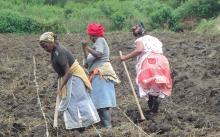Land Library
Welcome to the Land Portal Library. Explore our vast collection of open-access resources (over 74,000) including reports, journal articles, research papers, peer-reviewed publications, legal documents, videos and much more.
/ library resources
Showing items 1 through 9 of 102.In this research highlight, we present analysis of agricultural land use, distribution, access, tenure, land markets, and historical patterns of ownership and disposal.
Producing adequate food to meet global demand by 2050 is widely recognized as a major challenge, particularly for Africa south of the Sahara, including Tanzania (Godfray et al. 2010; Alexandratos and Bruinsma 2012; van Ittersum et al. 2016).
Following the end of apartheid, South Africa’s government set itself ambitious goals with a planned land reform. However, there have since been barely any changes in the country’s agricultural structure, and the positive impacts that were hoped for on rural livelihoods have hardly materialised.
This report presents findings of a study conducted in three districts of Odisha to examine the state of delivery and use of ten select essential nutrition interventions (ENIs) and the role of intersectoral coordination in their delivery.
Family farms are especially well suited to meet the challenges of labour organisation in agriculture. In early stages of development, they play a particularly important role in creating productive employment for the major share of the population.
For a long time, the agricultural policies of the Mercosur states ignored family farming, focusing on promoting individual crops and export production instead. Rural development was not on the agenda. Only after the turn of the millennium did a process of rethinking set in.
Providing extension and advisory services is expensive. There are salaries to be paid, transportation and operational funds to be provided, buildings to be rented or built, demonstration plots to maintain, and continued education to be offered to the extension staff.
Publicly elected women representatives in India ought to take advantage of their influence to defend women’s rights.
While government spending on pro-poor community asset creation and income-transfers could have compounding positive effects on poverty reduction, it is important to first study trends in the allocation of funds, particularly as they relate to the susceptibility of the program to political cliente







